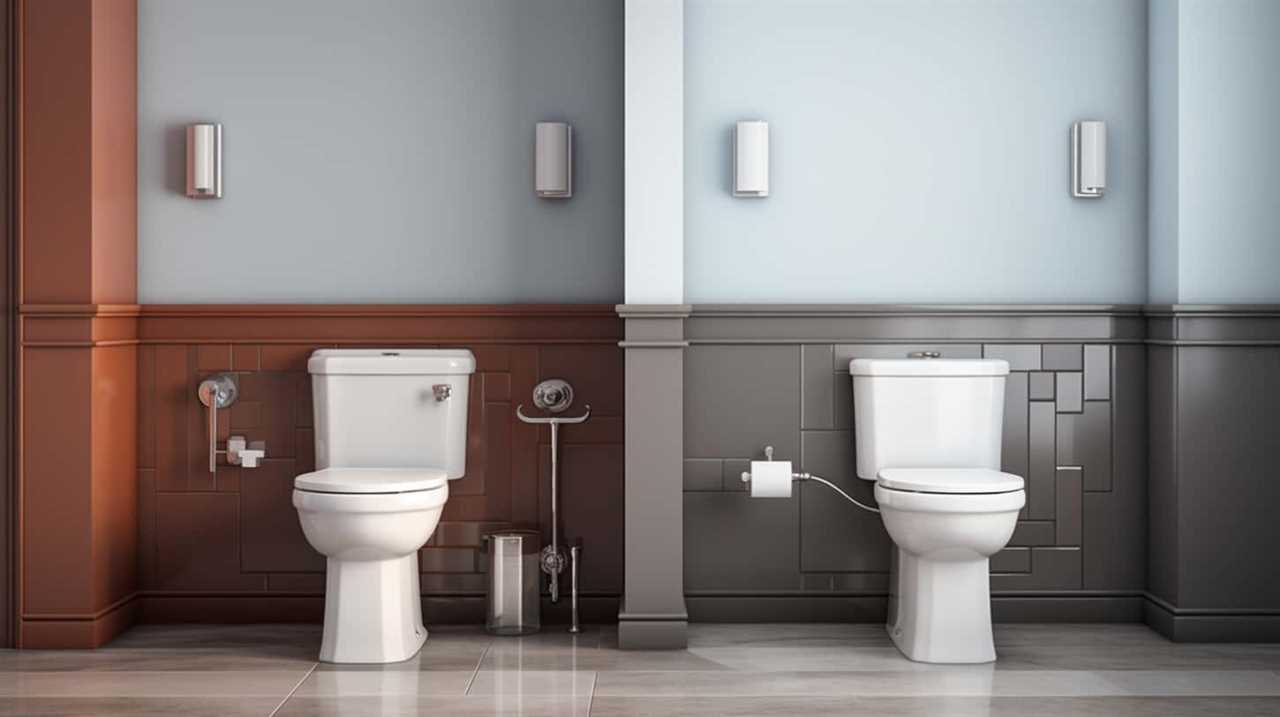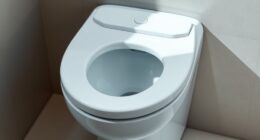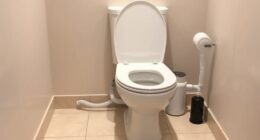Did you know that over time, toilet seat bolts can become rusted and nearly impossible to remove? It’s a frustrating problem that many of us have encountered.
But fear not! In this article, I’ll guide you through the process of removing those stubborn rusted bolts with ease.
I’ll share practical tips, techniques, and preventive measures to ensure you never have to deal with this issue again.
So let’s get started and say goodbye to rusted toilet seat bolts for good!
Key Takeaways
- Examine the bolts closely for signs of corrosion.
- Determine if the rust has affected the integrity of the bolts.
- Superficial rust can be fixed with rust removal methods.
- Extensive rust and weakened bolts require professional help.
Assessing the Rust Severity
To determine how severe the rust is, you’ll need to assess the condition of the toilet seat bolts. Start by examining the bolts closely. Look for any signs of corrosion, such as discoloration or flaking.
If the rust is only superficial and hasn’t affected the integrity of the bolts, you can try using rust removal methods to fix the issue yourself. Popular options include using vinegar, lemon juice, or a rust dissolver.
However, if the rust is extensive and the bolts are weakened or damaged, it’s best to seek professional help. A plumber or handyman will have the expertise and tools to safely remove the rusted bolts and replace them with new ones, ensuring the toilet seat remains secure and functional.
Gathering the Necessary Tools
First, you’ll want to grab a pair of pliers and a wrench to help with the task.
When removing rusted toilet seat bolts, it’s important to choose the right lubricant. WD-40 or a penetrating oil can work wonders in loosening the rust and making the bolts easier to remove.
Before starting, make sure to take some safety precautions. Wear protective gloves to prevent any cuts or scrapes. It’s also a good idea to wear safety goggles to shield your eyes from any debris.
To ensure stability, place a towel or cloth on the toilet seat to prevent it from moving.
Once you have everything in place, spray the lubricant generously on the rusted bolts and let it sit for a few minutes.
With the pliers, grip the bolt firmly and use the wrench to turn it counterclockwise. Apply steady pressure, but be careful not to overtighten and risk damaging the toilet.
Repeat the process for all the bolts until the toilet seat is completely detached.
Applying Lubrication for Loosening
Using a lubricant like WD-40 or penetrating oil can help make the rusted bolts easier to loosen. When it comes to applying lubrication, there are a few things to keep in mind. Here are some important points:
-
Choose the right lubricant: Different types of lubricants, such as WD-40, penetrating oil, or silicone spray, can be used depending on the severity of rust.
-
Apply generously: Make sure to apply a liberal amount of lubricant to the rusted bolts, ensuring that it penetrates deep into the rust.
-
Allow time to work: Give the lubricant some time to work its magic. Let it sit for at least 15-30 minutes before attempting to loosen the bolts.
-
Avoid excessive force: It’s important to remember not to apply excessive force when trying to loosen rusted bolts. This can lead to stripping or breaking the bolts.
-
Reapply if necessary: If the bolts are still not loosening after the initial application, reapply the lubricant and give it more time to work.
Using Proper Techniques to Remove Bolts
Once the lubricant has had enough time to work, you can proceed with removing the rusted bolts by applying proper techniques.
When it comes to bolt removal alternatives, there are a few options you can try. One method is to use a bolt extractor tool, which grips onto the bolt and allows you to twist it out.
Another option is to use heat, such as a propane torch, to expand the metal and loosen the rusted bolt. However, it’s important to be cautious when using heat, as it can damage surrounding materials.
Common mistakes when removing rusted bolts include using excessive force, which can strip the bolt or break the surrounding fixture. It’s also important to use the correct size and type of wrench or socket to avoid damaging the bolt further.
Preventive Measures for Future Rusting
One way to prevent future rusting is by regularly applying a protective coating to metal surfaces. This simple step can significantly extend the lifespan of your metal objects and keep them looking their best.
Here are some practical tips to help you prevent rusting:
-
Choose durable materials: Opt for metals that are less prone to rusting, such as stainless steel or galvanized steel.
-
Regular cleaning and maintenance: Keep your metal surfaces clean and dry to prevent moisture from causing rust. Use a mild detergent and a soft cloth to clean the surfaces regularly.
-
Apply a protective coating: Use a rust-resistant primer and paint to create a barrier between the metal and the elements.
-
Avoid exposure to harsh environments: If possible, keep metal objects away from excessive moisture, saltwater, and chemicals that can accelerate rusting.
-
Inspect for damage and repair promptly: Check for any signs of rust or damage, and repair or replace affected areas as soon as possible.
Frequently Asked Questions
Can I Use Vinegar as a Lubricant to Loosen Rusted Toilet Seat Bolts?
Yes, vinegar can be used as a lubricant to effectively loosen rusted toilet seat bolts. It is a practical and cost-effective method. Simply soak the bolts in vinegar for a few hours, then try loosening them with a wrench.
How Frequently Should I Check My Toilet Seat Bolts for Rust?
I regularly check my toilet seat bolts for rust to ensure proper toilet seat maintenance. By doing this, I can prevent rust from forming and causing difficulties in removing the bolts in the future.
Is It Necessary to Replace the Toilet Seat if the Bolts Are Rusted?
It’s not always necessary to replace the toilet seat if the bolts are rusted. With proper toilet seat maintenance and preventive measures to avoid rusted bolts, you can remove the rust and keep your seat intact.
Can I Use a Hairdryer to Apply Heat to the Rusted Bolts?
I wouldn’t recommend using a hairdryer to apply heat to rusted bolts as it can be a safety hazard. Instead, try using a penetrating oil to loosen the rust and make it easier to remove the bolts.
What Are Some Alternatives to Using a Wrench to Remove Rusted Toilet Seat Bolts?
Using penetrating oil and a hacksaw are effective alternatives to using a wrench for removing rusted toilet seat bolts. I’ve found that "where there’s a will, there’s a way" holds true in these situations.
Conclusion
In conclusion, tackling rusted toilet seat bolts can be a daunting task, but with the right tools and techniques, it can be conquered.
Just like a brave knight facing a mighty dragon, we must assess the severity of the rust, gather our tools like a trusty sword and armor, apply lubrication like a shield to loosen the bolts, and use proper techniques to remove them.
And just as the knight learns from their battles, we must take preventive measures to avoid future rusting.
With these steps, victory over rusted toilet seat bolts is within our grasp.










